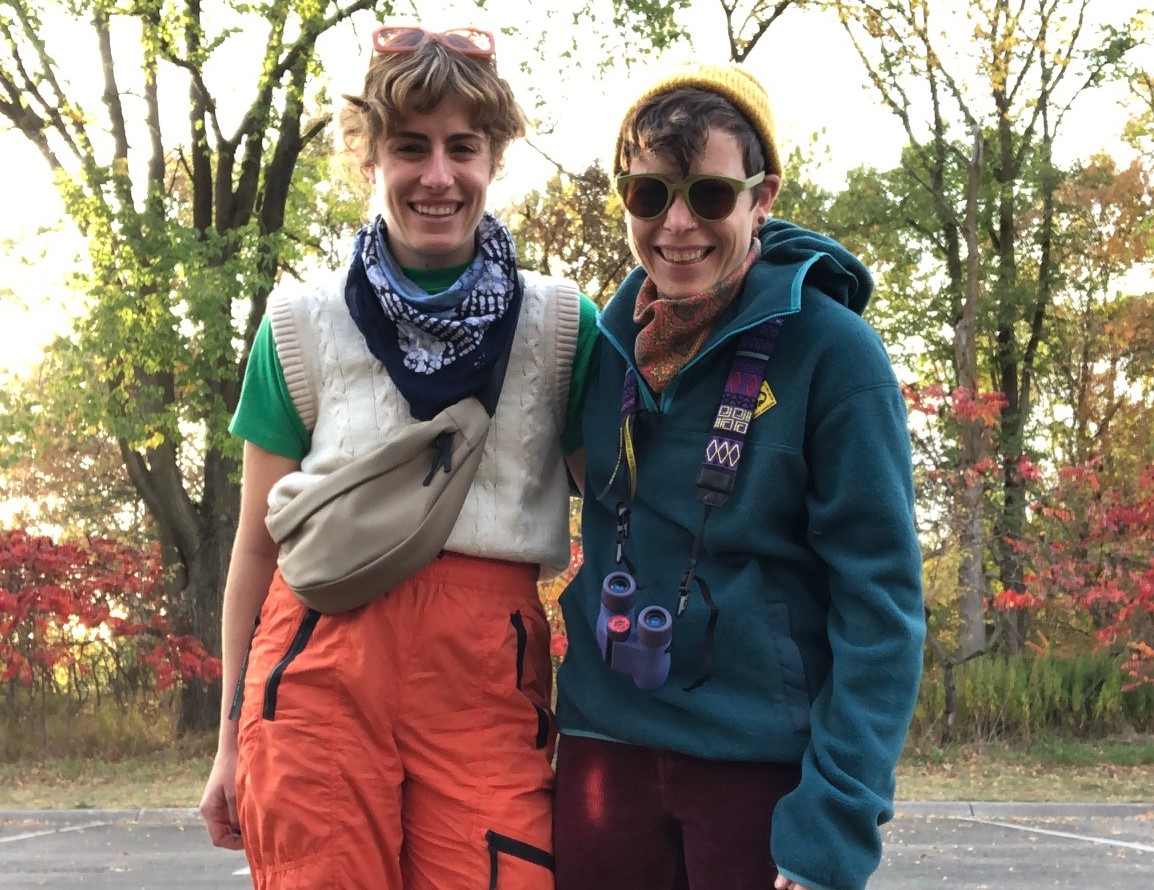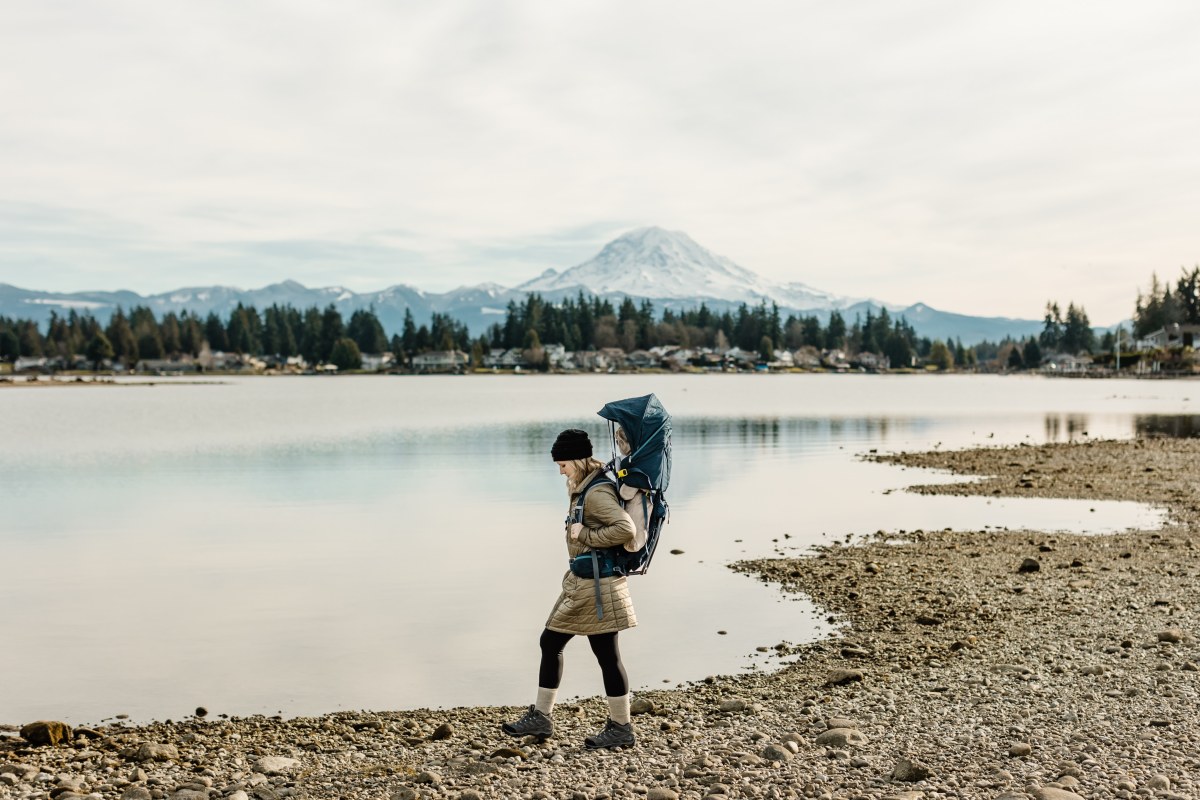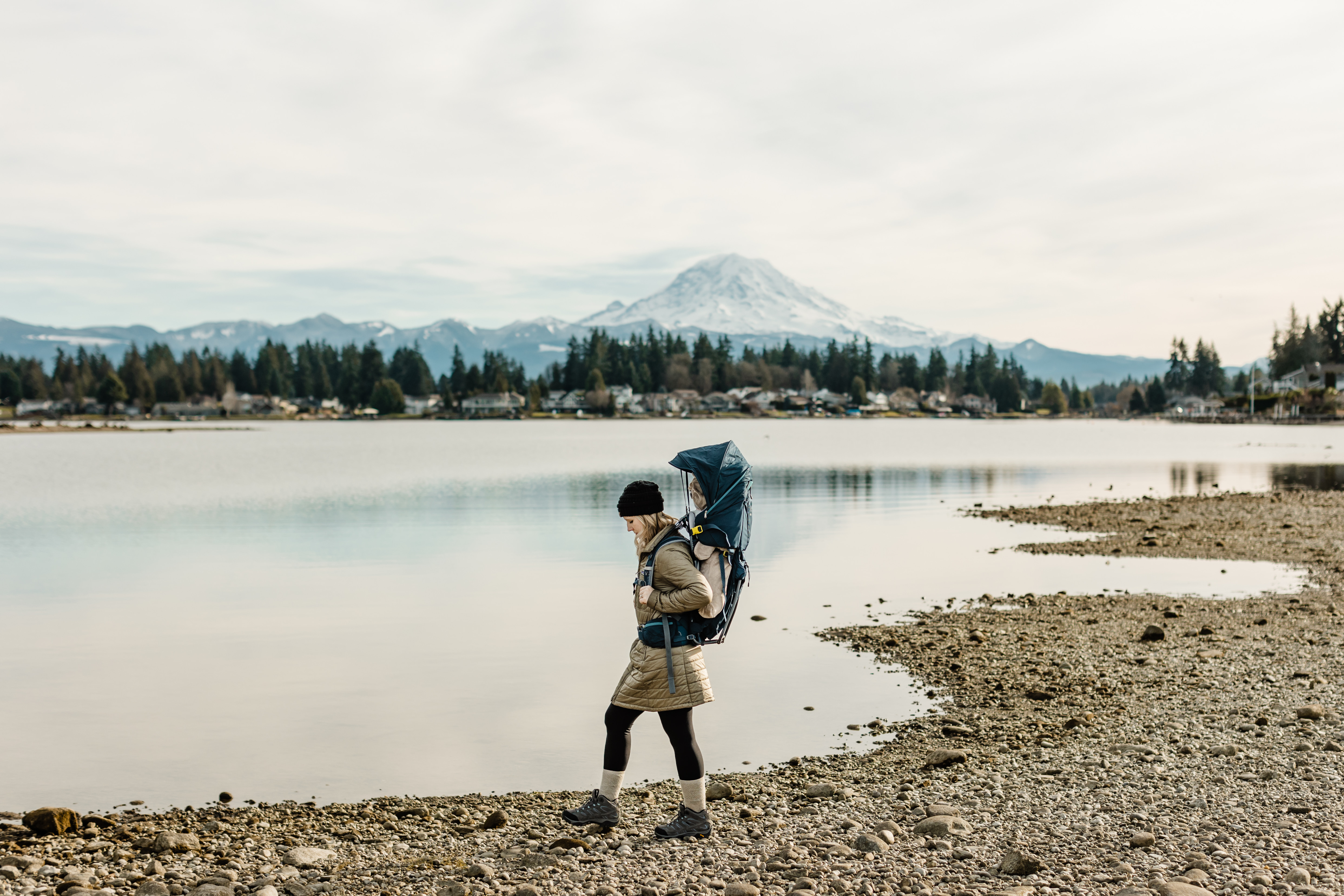Outdoor history is rich with stories of achievement and adventure across gender lines. In fact, the co-op’s own story began with co-founder Mary Anderson hand-stitching tents in her Seattle home. This year, we’re honoring the many ways people experience nature by asking folks, “What gets you outside?”
In the essays that follow, members and employees share what motivates them to spend time outdoors. A new mom writes about how her infant daughter inspires her to rethink what it means to care for the natural world. And a birder discovers that their newfound hobby introduces them to a different side of nature.
Read on for stories that embrace the many ways people enjoy time outside.
Jump Ahead
- A Birder Learns the Art of Observation: It’s amazing how well you can hear a hummingbird’s wings thrumming when you’re sitting in a comfortable silence and falling in love.
- Outside Is for the Dogs: I love watching my dogs on a scent, running in and out of the trees or galloping to the top of an outcropping, standing statue still and listening intently to something I’ll never hear.
- Teaching My Daughter to Love the Outdoors: Today, I love the outdoors just as much as ever, but it’s my daughter, Mya, who now inspires me to appreciate and protect it.
- Taking a Pause Outside: What gets me outside is not the personal record, the summit or the medal. It’s often the opposite. I retreat to the outdoors for a pause from a world that requires constant doing.
A Birder Learns the Art of Observation

My partner is the “noticer” in the family: She’s always the first one to point out a beautiful leaf or an interesting pattern of lichen on a tree. Maybe it’s because she works with children or because she’s an artist—or maybe it’s because she’s a Cancer sun sign—but she seems to have been born with an eye that automatically seeks what’s beautiful, peculiar or awe-inspiring.
From the moment Hannah and I started dating in 2018, I wanted to experience the same wonder and delight that she does when we’re on the trail or in a canoe. As someone who historically struggles to stop and look at, let alone smell, the roses, I knew I needed all the help I could get.
It was really only in those early months of our relationship that I started to pay close attention when I was out in the woods, and the first things to catch my eye were birds. Gosh, there are so many kinds of them! Growing up in suburban New Jersey taught me how to fight seagulls for my French fries and pigeons for space on the sidewalk, but I didn’t exactly go out looking for winged creatures in my spare time, so I wasn’t prepared for how many types of finches and swifts I’d see once I started looking.
On a trip to Maine a few years ago, I amused the very outdoorsy pals I was visiting by shouting, “Guys, look! A cardinal! In the wild!” That same weekend, they showed me how to tell a northern flicker from a red-bellied woodpecker, and I was seriously impressed—if a little intimidated. Would I ever be able to tell the difference?
When I got back to my adopted home in Minnesota, I started seeing more wings and beaks on my walks around town and runs around the lakes, and I watched them with renewed interest: leggy and solitary blue herons, wild-eyed loons with their spooky calls, red-wing blackbirds that click out a weird staccato across the water.
After a few months together, during our first shared summer, Hannah and I started going on walks. By then, I could at least do a little bit of bird identification. I pointed out one of her favorites (Baltimore oriole) one afternoon; another time, I shouted, “Bluebird!” pointing out the passenger window while driving us home from a family visit in Wisconsin. At the lakeside cottage she grew up visiting, we sat for hours on the screen porch, staring at the bird feeders. It’s amazing how well you can hear a hummingbird’s wings thrumming when you’re sitting in a comfortable silence and falling in love.
To me, Hannah’s cherishing the details in the vast world around her has felt like an invitation to keep looking up. Before I met her, I could see birds, but spending so much time with her has helped me really notice them.
And the more I notice, the closer I want to get. But I also believe in walking as lightly as I can: Observe the world around you, don’t interrupt or interfere with it, keep a respectful distance. Problem solved: Now we bring along a pair of binoculars whenever we head outside, passing them giddily back and forth and pointing out things that the other might have missed. We’ve seen as many as five bald eagles gracefully swooping and soaring overhead at the dog park by the river (hold on to your chihuahuas) and caught sight of goldfinches helping themselves to sunflower seeds in our backyard. I’ve made Hannah watch countless cardinals by now—yes, in the wild. We’ve even stared at a full moon on a clear fall night, amazed that something so far away could feel so close.
The act of noticing seemed far away when I first started too; suddenly it feels much more accessible. Now, when I focus my lenses on a speckle-feathered friend with a splash of red on its crown, I can call it instantly: It’s more than a flicker. It’s a full-blown passion.
—Ever Meister, Editor, REI Co-op Member since 2012
Outside Is for the Dogs

Outside is a place I’ve always felt comfortable. I’m lucky because I grew up in a place where getting outside was easy—I could walk or ride my bike anywhere. I could go camping or spend the day at the beach. My life situation has afforded me the opportunity to travel the world and spend time in all sorts of natural spaces. I can talk at length about the peaks I’ve bagged, the national parks I’ve explored and more. But when I truly sit down and remember the best times I’ve had outside, those times aren’t in the most far-flung, exotic or adventurous places. The experiences I look back on most fondly are the ones that include my dogs.
When I adopted my dogs, I did so with the intention that we would be spending lots of time outside together. I saw them becoming my companions out in nature—no more solo hikes or solitary camping trips. But even with all my plans for the relationship I would foster with my pups, I really had no idea how much they would change how I experienced the outside world.
First of all, they are hyper-aware of their surroundings—which not only helps me to be more aware but also allows me to drop my guard and more fully immerse myself on the trail. I know they have my back. When camping, I sleep like a baby, secure that my four-legged tent roomies will alert me if anything or anyone approaches our campsite.
Even though they are full of energy, our hikes together are much slower than my solo hikes. My dogs have taught me to stop and smell the daffodils! Well, they’re not exactly on the trail smelling the flowers—you don’t want to smell whatever they are sniffing at—but while they are entranced by something interesting, I have time to take a closer look at nature too. For me, that means flowers and mushrooms mostly, and I’ve developed a bit of an obsession with spotting pileated woodpeckers. My dogs’ curiosity has made me more curious.
With my dogs, my hiking goal is no longer how far and how fast I can go. Trails I could have completed in two hours before having dogs now take four hours. My Garmin Connect friends sometimes message me and say, “It took you three hours to hike 6 miles? Did you get lost??” My reply is always, “Yes! Deliciously lost in the woods with my pups!”
Our outside goal now is simply to enjoy time together in the fresh air. I love watching my dogs on a scent, running in and out of the trees or galloping to the top of an outcropping, standing statue still and listening intently to something I’ll never hear.
Another characteristic of my pre-dog adventures was traveling light. I would maybe take a bottle of water or a protein bar, as long as they could fit in my pockets. Nowadays, I stock my REI Co-op Flash 22 pack with water, dog snacks, Joyce snacks, a dog-friendly first-aid kit, small binoculars and a sketch pad with pencils. Lately, I’ve even taken to packing my Jetboil Zip, collapsible mug and some Alpine Start coffee or hot cocoa, depending on the season. I mean, I wouldn’t call it glam-hiking, but the dogs and I like to have some luxury items along while we’re out in nature.
I really have to laugh at myself when I hoist that pack onto my back. Who the heck am I? I’m a nature lover who has found a key to getting even closer to nature—enjoying it with a bunch of dogs.
I often encounter other hikers, many of whom will stop to pet my dogs. So many of them say, “I should bring my dog out here.”
“Yes!” I say. “You should. You will discover that you’re only seeing a small part of nature. You need a dog to show you what you’re missing!”
—Joyce Dierschke, Retail Sales Manager, REI Brentwood
Teaching My Daughter to Love the Outdoors

For many who grew up in the Pacific Northwest, being outside is how we remember childhood. Maybe we learned about seasons by seeing them change before our eyes. We discovered textures through objects provided by nature—like prickly pine cones and fluffy-headed dandelions. We know the difference between a mountain and a volcano and could proudly point them out on a clear day.
Born and raised in Washington state, I’m no exception. My most memorable moments were summers spent hopping between campsites and winters snowboarding in the mountains. I didn’t know how lucky I was to have the great outdoors as my playground, and never would have dreamed those majestic places would look a lot different by the time I had children.
It wasn’t until my adult life that I began to understand how the local landscapes I knew and loved were changing due to a warming climate. I noticed it in the mountains first. From Mount Rainier to Mount Hood, it seemed like the snow was melting faster each year—and it was. Research suggests that mountain snowpack in the Cascades is among the most vulnerable to climate change’s effects in the U.S. By 2070, the Pacific Northwest could see little to no annual snowpack.
Recognizing this environmental change sparked a concern in me that’s never left. It made me value my relationship with nature in an entirely new way. I realize that the choices I make will have a lasting impact on the planet that future generations will bear.
Today, I love the outdoors just as much as ever, but it’s my daughter, Mya, who now inspires me to appreciate and protect it. At less than a year old, she’s already visited her first national park, gone on hikes with mom and dad and experienced two whole seasons.
As she gets older, I’ll share memories of my favorite outdoor adventures with her in hopes that it will inspire her to create her own. I’ll also teach her to be grateful for the place we live, while showing her what she can do to help preserve it. If I do my job right, she’ll know not to litter because that trash could end up in the habitat of an animal that supports our ecosystem. She’ll see what it’s like to grow the fruits and vegetables that end up on our plates for dinner. And she’ll know that reusing as much as we can before we buy new things is one way we can do our part to reduce waste.
I know I’ll be up against far more technological distractions competing for her attention than existed when I was a kid. But by exposing her to nature as early and often as possible, I hope to help her decide for herself that living a life outdoors is much better than living it in front of a screen.
—McKenna Ownby, REI Co-op Member since 2019
Gear Up Like Mya
Deuter Kid Comfort Pro Child Carrier
Mya is a fan of the built-in sunshade, and I’m a fan of the back support. We also love the extra compartment for storage and mini pocket mirror, which helps me keep an eye on her.
For when Mya’s best friend (our pup, Zoey) joins us outside—we rarely go anywhere without her!
Stasher Reusable Silicone Sandwich Bags
A must-have for enjoying snacks on the go without the waste of single-use plastic.
Taking a Pause Outside

I used to find it a little bit funny that I ended up working in the outdoor industry. Though I grew up in the Pacific Northwest and have had many privileged opportunities to engage in outdoor recreation, I never saw myself as “outdoorsy.”
But at my core, I know that spending time outside has been integral to my development, my healing and my continued connection with myself and the world around me. As I’ve thought about it, especially over the last two years since working at REI, what really gets me outside is to be, not to do.
What do I mean by that? When I am outside, it’s rarely for a specific activity. Sure, I’ll choose to walk or jog or maybe cycle. But what gets me outside is not the personal record, the summit or the medal. It’s often the opposite. I retreat to the outdoors for a pause from a world that requires constant doing. I go to process what’s happening in life while feeling the sun on my face (when we’re lucky enough to have it in the Pacific Northwest). I go to connect with a friend while strolling around a local lake or sitting on a patio with a coffee. I go to watch my children jump in puddles or excitedly collect fall leaves. I go to take a break from the constant input of information, opinions and the general volume of our society. I also go to practice breathing and thinking and to remind myself of just how big the world is when life feels all-consuming.
Last year, I purchased the Outdoor Journal Tour’s Nature Meditations Deck, which contains meditations, journaling prompts and other mindfulness practices to be used outside. These beautiful cards were so helpful to me in moments of dysregulation or overwhelm. I’d pull one (usually from the “strengthening affirmations” or “messages from the Earth” sections), read it and use it as a sort of mantra while on a walk.
One example is from the card titled, Take the Space You Need: “Trees are only as strong and healthy as their root systems … Today, imagine yourself as a tree putting down roots. Gently say to yourself, I will take the space I need. Then, give yourself permission to be as wide and deep as you need to be.”
Research has demonstrated the positive impact of walking on mental health, and I felt like the meditations deck added an extra spiritual level to the experience. They’re now a piece of my ever-growing toolkit for personal well-being.
I know now that it isn’t a coincidence that I ended up working in this industry. I believe that there are many of us who see time outside as less of a vehicle for achievement and more of one for rest and reconnection. Less doing, more being. That gets me outside.
—Nani Vishwanath, Senior Program Manager of REDI Innovation at REI


